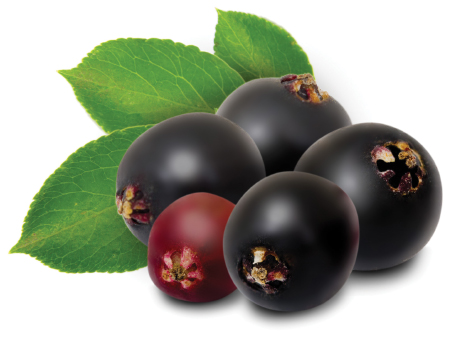
Yen Nien Hou, PharmD, DiplOM, LAc

Jyothirmai Gubili, MS
The ASCO Post’s Integrative Oncology series is intended to facilitate the availability of evidence-based information on integrative and complementary therapies sometimes used by patients with cancer. In this installment, Yen Nien Hou, PharmD, DiplOM, LAc, and Jyothirmai Gubili, MS, focus on elderberry because of its popularity as a remedy for colds, flu, and respiratory diseases.
Scientific Name: Sambucus nigra
Common Names: Elder, elderberry, European elderberry, black elder, black elderberry, sambucus
Overview
Elderberry is a flowering shrub native to Europe that is cultivated in many parts of the world for culinary and medicinal purposes. The mature berries are edible and used to prepare wine, jams, syrups, and pies.
The flowers and fruit are employed to reduce cold and flu symptoms, sinusitis, inflammation; to treat respiratory diseases; and to relieve constipation. Among the many species of elderberry, European Elder (S nigra) is the most studied and often used in dietary supplements marketed as syrups, gummies, lozenges, capsules, and teas. However, the U.S. Food and Drug Administration has warned manufacturers against making unsubstantiated claims that elderberry juice prevents or treats various diseases, including AIDS, diabetes, and flu.1,2
The Science
Elderberries are a rich source of anthocyanins, flavonoids, phenolics, and other nutrients, and have demonstrated antiviral,3 antibacterial,4 antidiabetic,5 immunomodulatory,6 anti-inflammatory,7 and chemopreventive effects in vitro,8 but clinical data are limited.
A small randomized crossover study involving 20 adults with chronic constipation showed an elderberry formulation (consumed as a tea for 5 days) to be safe and effective for improving the colonic transit time (P < .001).9
GUEST EDITOR
Integrative Oncology is guest edited by Jun J. Mao, MD, MSCE, Laurance S. Rockefeller Chair in Integrative Medicine and Chief of Integrative Medicine Service at Memorial Sloan Kettering Cancer Center, New York.

Jun J. Mao, MD, MSCE
But elderberry (500-mg anthocyanins, taken daily for 12 weeks) was found to be ineffective in altering biomarkers of cardiovascular disease in healthy postmenopausal women (n = 50).10 Another study reported a minor, statistically insignificant change in cholesterol levels following consumption of spray-dried elderberry juice (400 mg, three times daily for 2 weeks).11
Investigations of elderberry’s potential against cold and flu suggest potential benefits. For instance, in a randomized trial of 60 patients with influenza-like symptoms for up to 48 hours, 15 mL of elderberry juice (four times daily for 5 days) was effective in relieving symptoms 4 days earlier compared with placebo. The use of rescue medication was also significantly less in the group receiving elderberry (P < .001).12
In another study conducted during an influenza outbreak (n = 40, with symptoms for less than 24 hours), a standardized elderberry extract (60 mL, consumed daily for 3 days) resulted in significant improvement in symptoms, including fever, within 2 days of beginning the treatment. Similar benefits were also seen in the placebo group but within 6 days of initiating the treatment (P < .001).13
Larger trials are needed to confirm these effects. The long-term safety of elderberry also remains to be determined.14
Mechanistic studies revealed that flavonoids present in elderberry bind to H1N1 virions and block the ability of viruses to infect host cells.3 They may also prevent HIV type 1 infection by binding to viral glycoproteins such as gp120.15 The anti-inflammatory effects of elderberry are thought to be due to increased cytokine production7 or inhibition of nuclear transcription factor kappaB and phosphatidylinositol 3-kinase.16
OF NOTE
Physicians should be aware of the popularity of elderberry; the lack of robust data to support its use for colds and flu; its potential to interact with prescription drugs; and the risk of cyanide toxicity following consumption of raw or unripe fruits, leaves, and stems.
In other studies, an elderberry extract lowered serum triglycerides, inflammatory markers, and insulin resistance in a murine model of obesity17; and exerted antidiabetic properties via activating peroxisome proliferator-activated receptor gamma and stimulating insulin-dependent glucose uptake.5 Elderberry also affected hepatic gene expression in hyperlipidemic mice and may influence high-density lipoprotein dysfunction associated with chronic inflammation.18
Adverse Reactions
Type 1 allergy,19 gastrointestinal distress,20 and acute pancreatitis21 have been reported following the use of elderberry.
Case Report
A total of 11 people experienced nausea and vomiting, 8 of whom had acute gastrointestinal and neurologic symptoms, after consuming juice made from raw elderberries, leaves, and branches. Some also reported dizziness and numbness; one person who consumed mostly elderberry juice was hospitalized, but symptoms resolved in all the individuals with no treatment required.20
Herb-Drug Interactions
Antidiabetic drugs: Elderberry has hypoglycemic activity and may have additive effects following concomitant use.5
Cytochrome P4503A4 substrates: A commercial product containing Echinacea purpurea and S nigra was found to inhibit CYP3A4 activity, although the inhibitory potency appeared to be exerted by E purpurea.22
Diuretics: Elderberry promotes urination and may have cumulative effects when used simultaneously.23
The clinical relevance of the above interactions has yet to be determined.
Laxatives: Elderberry was reported to have laxative effects in clinical studies and can therefore have additive effects.9,24

Summary
Elderberry is used in traditional medicine for treating colds and respiratory ailments, but clinical evidence to support its use for flu symptoms is limited. Also, the safety of its long-term use has yet to be determined. When buying elderberry supplements, it is important to check for quality-assured products through third-party testing labs, such as ConsumerLab.com, or to buy ones that carry the U.S. Pharmacopeia-verified mark.
DISCLOSURE: Dr. Hou and Ms. Gubili reported no conflicts of interest.
REFERENCES
1. U.S. Food and Drug Administration: FDA seizes elderberry juice concentrate at Kansas company. June 3, 2011. Available at https://wayback.archive-it.org/7993/20170111235612/http:/www.fda.gov/NewsEvents/Newsroom/PressAnnouncements/ucm257781.htm. Accessed June 17, 2020.
2. Thole JM, Burns Kraft TF, Sueiro LA, et al: A comparative evaluation of the anticancer properties of European and American elderberry fruits. J Med Food 9:498-504, 2006.
3. Roschek Jr B, Fink RC, McMichael MD, et al: Elderberry flavonoids bind to and prevent H1N1 infection in vitro. Phytochemistry 70:1255-1261, 2009.
4. Krawitz C, Mraheil MA, Stein M, et al: Inhibitory activity of a standardized elderberry liquid extract against clinically relevant human respiratory bacterial pathogens and influenza A and B viruses. BMC Complement Altern Med 11:16, 2011.
5. Christensen KB, Petersen RK, Kristiansen K, et al: Identification of bioactive compounds from flowers of black elder (Sambucus nigra L.) that activate the human peroxisome proliferator-activated receptor (PPAR) gamma. Phytother Res 24(suppl 2):S129-S132, 2010.
6. Waknine-Grinberg JH, El-On J, Barak V, et al: The immunomodulatory effect of Sambucol on leishmanial and malarial infections. Planta Med May 75:581-586, 2009.
7. Barak V, Birkenfeld S, Halperin T, et al: The effect of herbal remedies on the production of human inflammatory and anti-inflammatory cytokines. Isr Med Assoc J 4(11 suppl):919-922, 2002.
8. Jing P, Bomser JA, Schwartz SJ, et al: Structure-function relationships of anthocyanins from various anthocyanin-rich extracts on the inhibition of colon cancer cell growth. J Agric Food Chem 56:9391-9398, 2008.
9. Picon PD, Picon RV, Costa AF, et al: Randomized clinical trial of a phytotherapic compound containing Pimpinella anisum, Foeniculum vulgare, Sambucus nigra, and Cassia augustifolia for chronic constipation. BMC Complement Altern Med 10:17, 2010.
10. Curtis PJ, Kroon PA, Hollands WJ, et al: Cardiovascular disease risk biomarkers and liver and kidney function are not altered in postmenopausal women after ingesting an elderberry extract rich in anthocyanins for 12 weeks. J Nutr 139:2266-2271, 2009.
11. Murkovic M, Abuja PM, Bergmann AR, et al: Effects of elderberry juice on fasting and postprandial serum lipids and low-density lipoprotein oxidation in healthy volunteers: a randomized, double-blind, placebo-controlled study. Eur J Clin Nutr 58:244-249, 2004.
12. Zakay-Rones Z, Thom E, Wollan T, et al: Randomized study of the efficacy and safety of oral elderberry extract in the treatment of influenza A and B virus infections. J Int Med Res 32:132-140, 2004.
13. Zakay-Rones Z, Varsano N, Zlotnik M, et al: Inhibition of several strains of influenza virus in vitro and reduction of symptoms by an elderberry extract (Sambucus nigra L.) during an outbreak of influenza B Panama. J Altern Complement Med 1:361-369, 1995.
14. No authors listed: Elderberry for influenza. Med Lett Drugs Ther 61:32, 2019.
15. Fink RC, Roschek Jr B, Alberte RS: HIV type-1 entry inhibitors with a new mode of action. Antivir Chem Chemother 19:243-255, 2009.
16. Harokopakis E, Albzreh MH, Haase EM, et al: Inhibition of proinflammatory activities of major periodontal pathogens by aqueous extracts from elder flower (Sambucus nigra). J Periodontol 77:271-279, 2006.
17. Farrell NJ, Norris GH, Ryan J, et al: Black elderberry extract attenuates inflammation and metabolic dysfunction in diet-induced obese mice. Br J Nutr 114:1123-1131, 2015.
18. Farrell N, Norris G, Lee SG, et al: Anthocyanin-rich black elderberry extract improves markers of HDL function and reduces aortic cholesterol in hyperlipidemic mice. Food Funct 6:1278-1287, 2015.
19. Forster-Waldl E, Marchetti M, Scholl I, et al: Type I allergy to elderberry (Sambucus nigra) is elicited by a 33.2 kDa allergen with significant homology to ribosomal inactivating proteins. Clin Exp Allergy 33:1703-1710, 2003.
20. Centers for Disease Control: Poisoning from elderberry juice—California. MMWR Morb Mortal Wkly Repb33:173-174, 1984.
21. Weissman S, Lo A, Patel R, et al: An unusual culprit of drug-induced pancreatitis. Dig Dis Sci 65:1549-1552, 2020.
22. Schrøder-Aasen T, Molden G, Nilsen OG: In vitro inhibition of CYP3A4 by the multiherbal commercial Ppoduct Sambucus Force and its main constituents Echinacea purpurea and Sambucus nigra. Phytother Res 26:1606-1613, 2012.
23. Beaux D, Fleurentin J, Mortier F: Effect of extracts of Orthosiphon stamineus Benth, Hieracium pilosella L., Sambucus nigra L. and Arctostaphylos uva-ursi (L.) Spreng. in rats. Phytother Res 13:222-225, 1999.
24. Tsui B, Dennehy CE, Tsourounis C: A survey of dietary supplement use during pregnancy at an academic medical center. Am J Obstet Gynecol 185:433-437, 2001.
Dr. Hou is Manager of Memorial Sloan Kettering Cancer Center’s “About Herbs” website. Ms. Gubili is Editor with the Integrative Medicine Service at Memorial Sloan Kettering Cancer Center, New York.

